Business and Corporation Law
VerifiedAdded on 2023/01/11
|7
|1434
|74
AI Summary
This document discusses various issues related to business and corporation law. It covers topics such as contracts, mutual mistakes, offer and acceptance, and liability. Case studies and legal principles are used to illustrate the concepts.
Contribute Materials
Your contribution can guide someone’s learning journey. Share your
documents today.
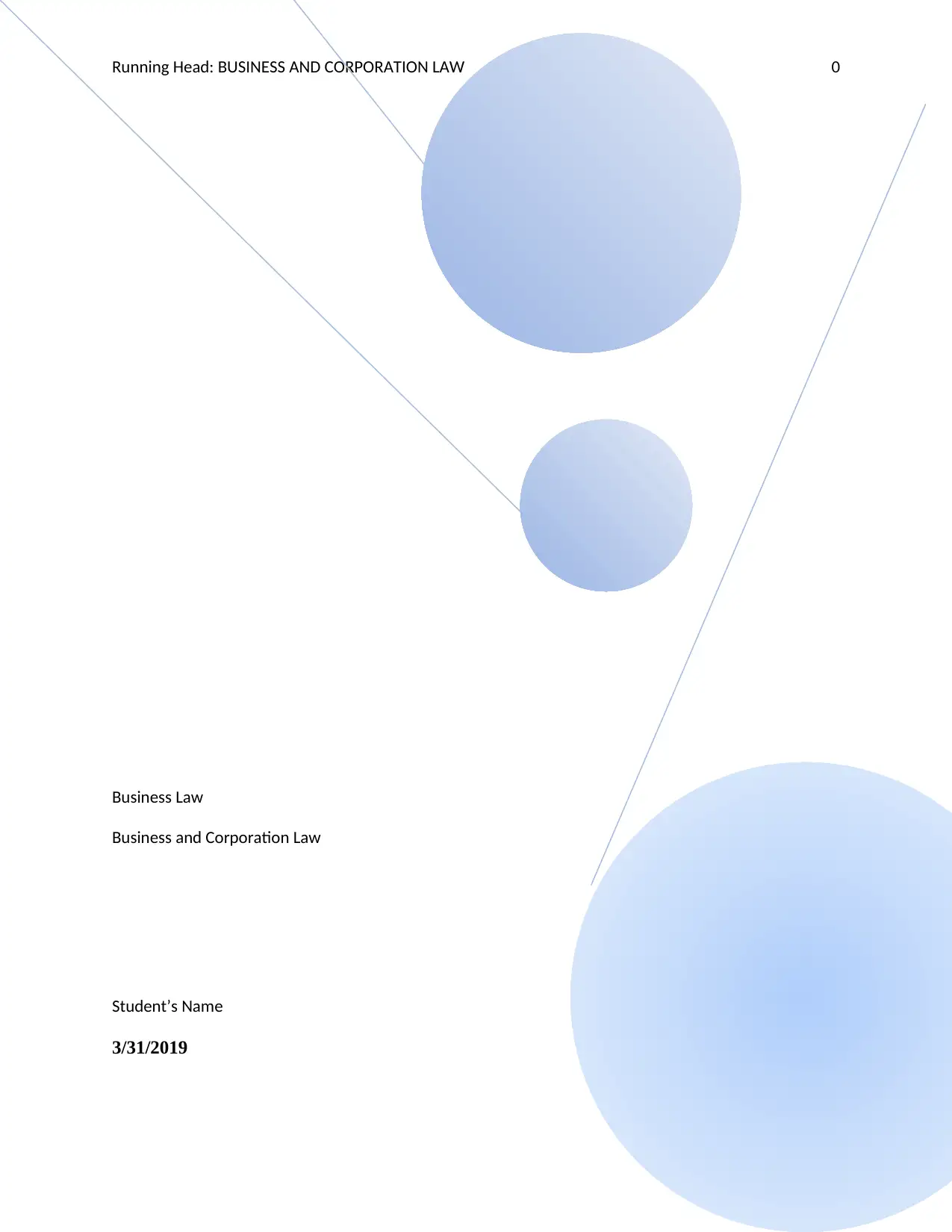
Running Head: BUSINESS AND CORPORATION LAW 0
Business Law
Business and Corporation Law
Student’s Name
3/31/2019
Business Law
Business and Corporation Law
Student’s Name
3/31/2019
Secure Best Marks with AI Grader
Need help grading? Try our AI Grader for instant feedback on your assignments.
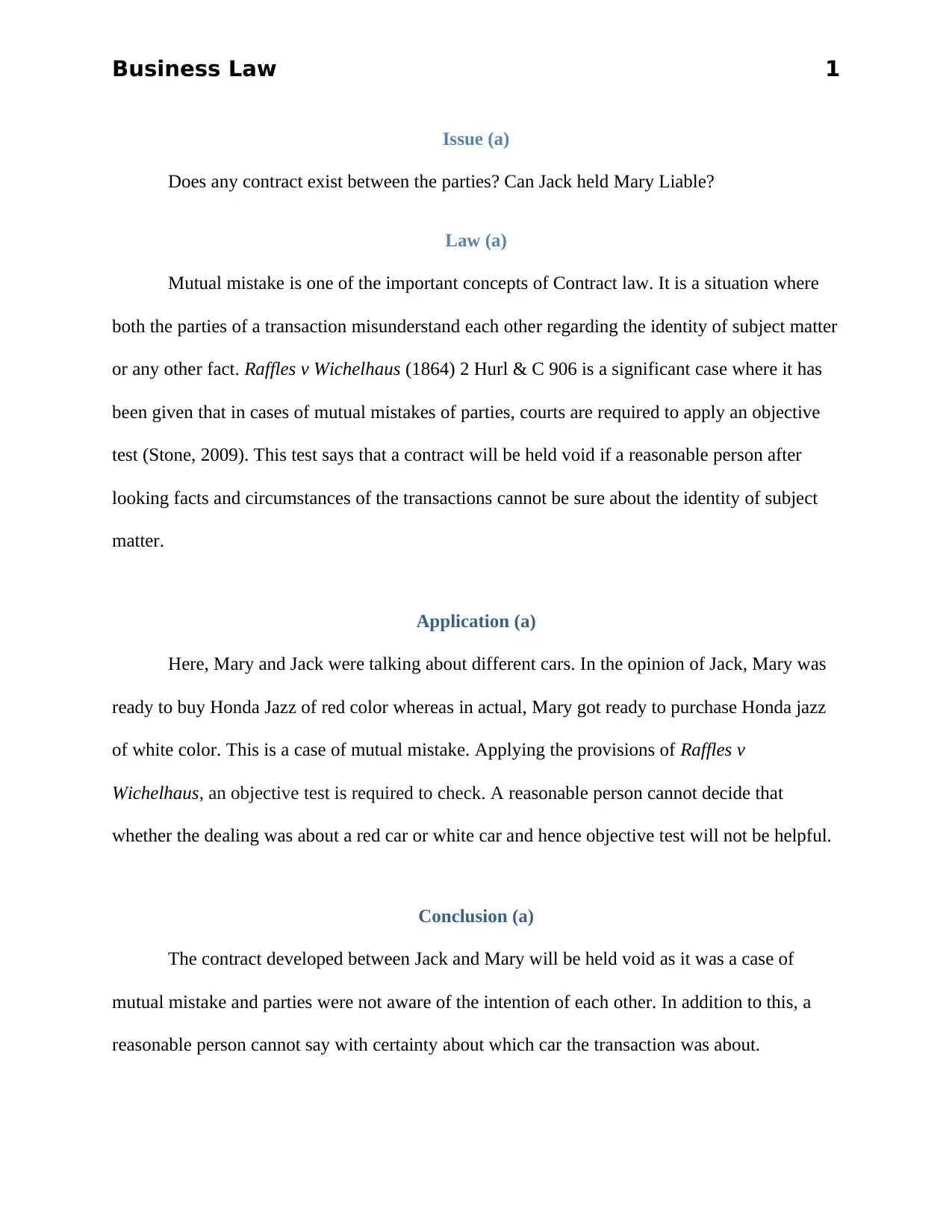
Business Law 1
Issue (a)
Does any contract exist between the parties? Can Jack held Mary Liable?
Law (a)
Mutual mistake is one of the important concepts of Contract law. It is a situation where
both the parties of a transaction misunderstand each other regarding the identity of subject matter
or any other fact. Raffles v Wichelhaus (1864) 2 Hurl & C 906 is a significant case where it has
been given that in cases of mutual mistakes of parties, courts are required to apply an objective
test (Stone, 2009). This test says that a contract will be held void if a reasonable person after
looking facts and circumstances of the transactions cannot be sure about the identity of subject
matter.
Application (a)
Here, Mary and Jack were talking about different cars. In the opinion of Jack, Mary was
ready to buy Honda Jazz of red color whereas in actual, Mary got ready to purchase Honda jazz
of white color. This is a case of mutual mistake. Applying the provisions of Raffles v
Wichelhaus, an objective test is required to check. A reasonable person cannot decide that
whether the dealing was about a red car or white car and hence objective test will not be helpful.
Conclusion (a)
The contract developed between Jack and Mary will be held void as it was a case of
mutual mistake and parties were not aware of the intention of each other. In addition to this, a
reasonable person cannot say with certainty about which car the transaction was about.
Issue (a)
Does any contract exist between the parties? Can Jack held Mary Liable?
Law (a)
Mutual mistake is one of the important concepts of Contract law. It is a situation where
both the parties of a transaction misunderstand each other regarding the identity of subject matter
or any other fact. Raffles v Wichelhaus (1864) 2 Hurl & C 906 is a significant case where it has
been given that in cases of mutual mistakes of parties, courts are required to apply an objective
test (Stone, 2009). This test says that a contract will be held void if a reasonable person after
looking facts and circumstances of the transactions cannot be sure about the identity of subject
matter.
Application (a)
Here, Mary and Jack were talking about different cars. In the opinion of Jack, Mary was
ready to buy Honda Jazz of red color whereas in actual, Mary got ready to purchase Honda jazz
of white color. This is a case of mutual mistake. Applying the provisions of Raffles v
Wichelhaus, an objective test is required to check. A reasonable person cannot decide that
whether the dealing was about a red car or white car and hence objective test will not be helpful.
Conclusion (a)
The contract developed between Jack and Mary will be held void as it was a case of
mutual mistake and parties were not aware of the intention of each other. In addition to this, a
reasonable person cannot say with certainty about which car the transaction was about.
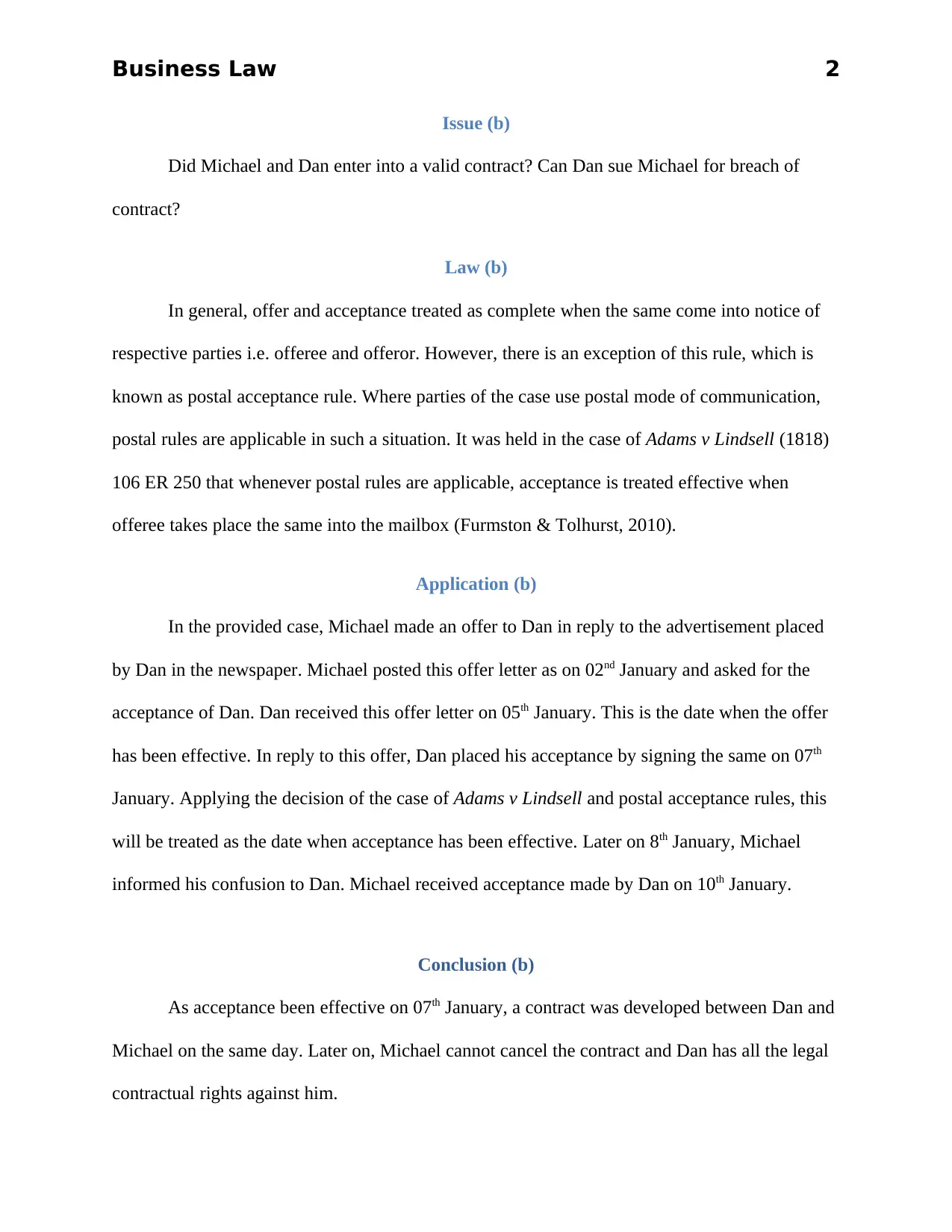
Business Law 2
Issue (b)
Did Michael and Dan enter into a valid contract? Can Dan sue Michael for breach of
contract?
Law (b)
In general, offer and acceptance treated as complete when the same come into notice of
respective parties i.e. offeree and offeror. However, there is an exception of this rule, which is
known as postal acceptance rule. Where parties of the case use postal mode of communication,
postal rules are applicable in such a situation. It was held in the case of Adams v Lindsell (1818)
106 ER 250 that whenever postal rules are applicable, acceptance is treated effective when
offeree takes place the same into the mailbox (Furmston & Tolhurst, 2010).
Application (b)
In the provided case, Michael made an offer to Dan in reply to the advertisement placed
by Dan in the newspaper. Michael posted this offer letter as on 02nd January and asked for the
acceptance of Dan. Dan received this offer letter on 05th January. This is the date when the offer
has been effective. In reply to this offer, Dan placed his acceptance by signing the same on 07th
January. Applying the decision of the case of Adams v Lindsell and postal acceptance rules, this
will be treated as the date when acceptance has been effective. Later on 8th January, Michael
informed his confusion to Dan. Michael received acceptance made by Dan on 10th January.
Conclusion (b)
As acceptance been effective on 07th January, a contract was developed between Dan and
Michael on the same day. Later on, Michael cannot cancel the contract and Dan has all the legal
contractual rights against him.
Issue (b)
Did Michael and Dan enter into a valid contract? Can Dan sue Michael for breach of
contract?
Law (b)
In general, offer and acceptance treated as complete when the same come into notice of
respective parties i.e. offeree and offeror. However, there is an exception of this rule, which is
known as postal acceptance rule. Where parties of the case use postal mode of communication,
postal rules are applicable in such a situation. It was held in the case of Adams v Lindsell (1818)
106 ER 250 that whenever postal rules are applicable, acceptance is treated effective when
offeree takes place the same into the mailbox (Furmston & Tolhurst, 2010).
Application (b)
In the provided case, Michael made an offer to Dan in reply to the advertisement placed
by Dan in the newspaper. Michael posted this offer letter as on 02nd January and asked for the
acceptance of Dan. Dan received this offer letter on 05th January. This is the date when the offer
has been effective. In reply to this offer, Dan placed his acceptance by signing the same on 07th
January. Applying the decision of the case of Adams v Lindsell and postal acceptance rules, this
will be treated as the date when acceptance has been effective. Later on 8th January, Michael
informed his confusion to Dan. Michael received acceptance made by Dan on 10th January.
Conclusion (b)
As acceptance been effective on 07th January, a contract was developed between Dan and
Michael on the same day. Later on, Michael cannot cancel the contract and Dan has all the legal
contractual rights against him.
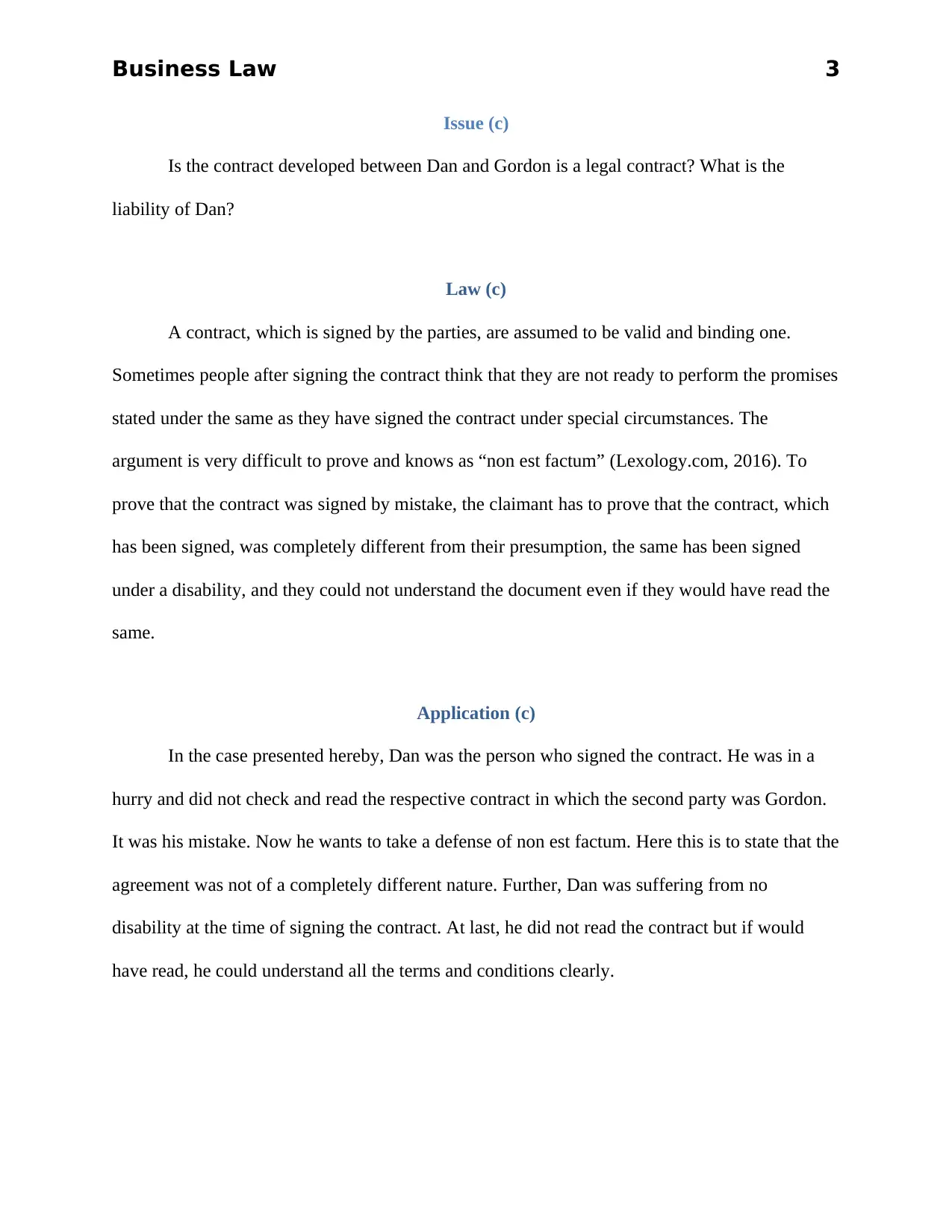
Business Law 3
Issue (c)
Is the contract developed between Dan and Gordon is a legal contract? What is the
liability of Dan?
Law (c)
A contract, which is signed by the parties, are assumed to be valid and binding one.
Sometimes people after signing the contract think that they are not ready to perform the promises
stated under the same as they have signed the contract under special circumstances. The
argument is very difficult to prove and knows as “non est factum” (Lexology.com, 2016). To
prove that the contract was signed by mistake, the claimant has to prove that the contract, which
has been signed, was completely different from their presumption, the same has been signed
under a disability, and they could not understand the document even if they would have read the
same.
Application (c)
In the case presented hereby, Dan was the person who signed the contract. He was in a
hurry and did not check and read the respective contract in which the second party was Gordon.
It was his mistake. Now he wants to take a defense of non est factum. Here this is to state that the
agreement was not of a completely different nature. Further, Dan was suffering from no
disability at the time of signing the contract. At last, he did not read the contract but if would
have read, he could understand all the terms and conditions clearly.
Issue (c)
Is the contract developed between Dan and Gordon is a legal contract? What is the
liability of Dan?
Law (c)
A contract, which is signed by the parties, are assumed to be valid and binding one.
Sometimes people after signing the contract think that they are not ready to perform the promises
stated under the same as they have signed the contract under special circumstances. The
argument is very difficult to prove and knows as “non est factum” (Lexology.com, 2016). To
prove that the contract was signed by mistake, the claimant has to prove that the contract, which
has been signed, was completely different from their presumption, the same has been signed
under a disability, and they could not understand the document even if they would have read the
same.
Application (c)
In the case presented hereby, Dan was the person who signed the contract. He was in a
hurry and did not check and read the respective contract in which the second party was Gordon.
It was his mistake. Now he wants to take a defense of non est factum. Here this is to state that the
agreement was not of a completely different nature. Further, Dan was suffering from no
disability at the time of signing the contract. At last, he did not read the contract but if would
have read, he could understand all the terms and conditions clearly.
Secure Best Marks with AI Grader
Need help grading? Try our AI Grader for instant feedback on your assignments.

Business Law 4
Conclusion (c)
The defense of non est factum is not available to Dan and the contract developed between
him and Gordon is a legally binding contract. Dan is liable to give the delivery of truck to
Gordon.
Issue (d)
What is the contractual position of Dan and Edgar?
Law (d)
Under contract law, there are two terms, which are confusing in mutual. These terms are
an offer and invitation to treat. This is to mention that an invitation to treat is simply a call for
offers and one may not accept the same as it is different from an offer (Taylor & Taylor, 2007).
Many of the times sellers put the label of wrong prices on goods. If the displayed goods would
be treated as offer then there are chances that customers can accept them on wrong prices just by
picking them up. To save the interest of the seller in such cases, common law provides that
displayed goods with price tags will be considered as an invitation to treat and not an offer. This
rule further supported in the decision given of the case of Pharmaceutical Society of Great
Britain v Boots [1953] 1 QB 401.
Application (d)
In the given case, Edgar visited car lot and chosen a 2009 Holden Statesman on which a
sticker of ‘$ 10 000 was placed. He went to Dan and stated that he is giving acceptance to buy
the subjective car. Dan realized that the price mentioned in sticker was not correct and he denied
to accept the offer by Edgar. Edgar, considering his statement as acceptance want to get the car.
Here to say that Edgar was first required to make the offer and he cannot give his acceptance as
Conclusion (c)
The defense of non est factum is not available to Dan and the contract developed between
him and Gordon is a legally binding contract. Dan is liable to give the delivery of truck to
Gordon.
Issue (d)
What is the contractual position of Dan and Edgar?
Law (d)
Under contract law, there are two terms, which are confusing in mutual. These terms are
an offer and invitation to treat. This is to mention that an invitation to treat is simply a call for
offers and one may not accept the same as it is different from an offer (Taylor & Taylor, 2007).
Many of the times sellers put the label of wrong prices on goods. If the displayed goods would
be treated as offer then there are chances that customers can accept them on wrong prices just by
picking them up. To save the interest of the seller in such cases, common law provides that
displayed goods with price tags will be considered as an invitation to treat and not an offer. This
rule further supported in the decision given of the case of Pharmaceutical Society of Great
Britain v Boots [1953] 1 QB 401.
Application (d)
In the given case, Edgar visited car lot and chosen a 2009 Holden Statesman on which a
sticker of ‘$ 10 000 was placed. He went to Dan and stated that he is giving acceptance to buy
the subjective car. Dan realized that the price mentioned in sticker was not correct and he denied
to accept the offer by Edgar. Edgar, considering his statement as acceptance want to get the car.
Here to say that Edgar was first required to make the offer and he cannot give his acceptance as
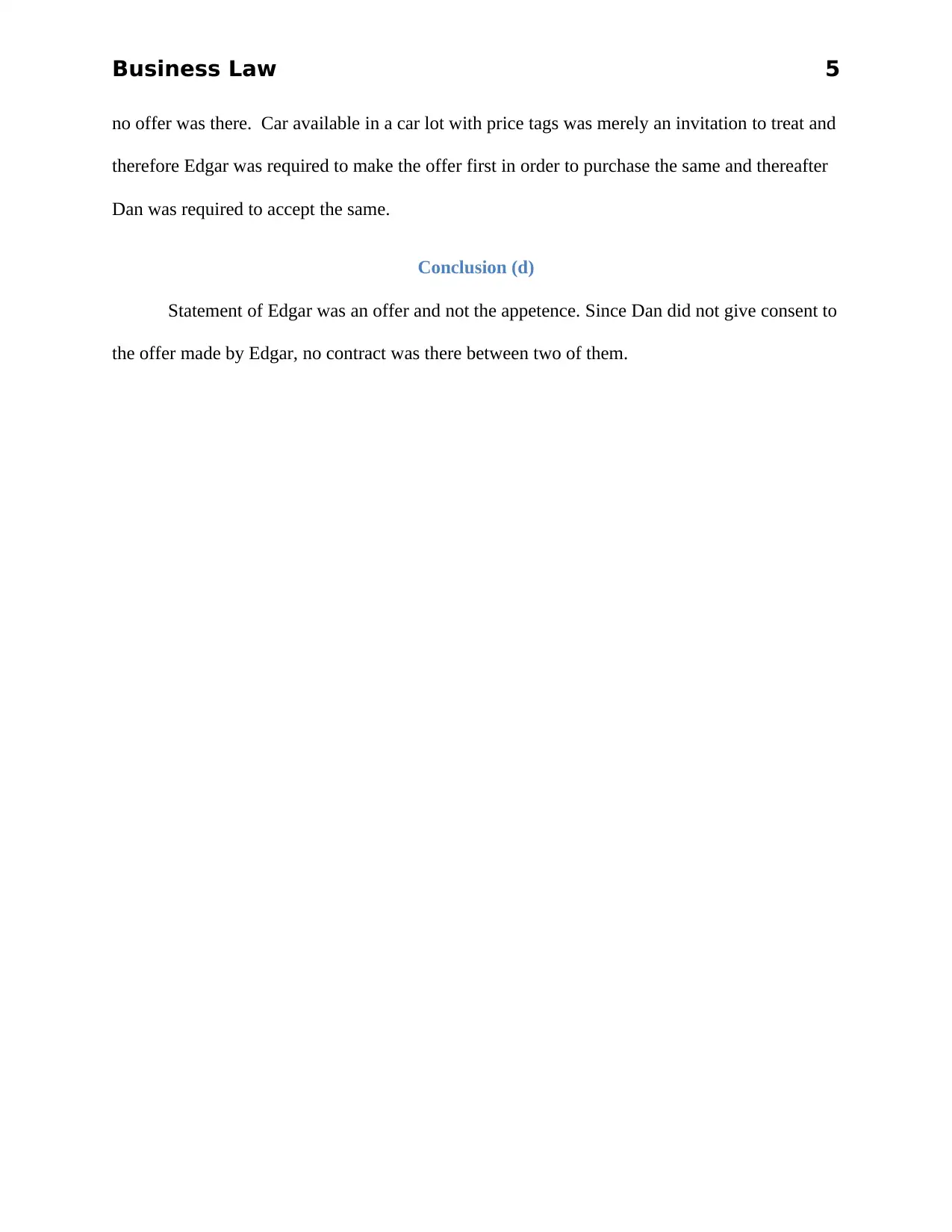
Business Law 5
no offer was there. Car available in a car lot with price tags was merely an invitation to treat and
therefore Edgar was required to make the offer first in order to purchase the same and thereafter
Dan was required to accept the same.
Conclusion (d)
Statement of Edgar was an offer and not the appetence. Since Dan did not give consent to
the offer made by Edgar, no contract was there between two of them.
no offer was there. Car available in a car lot with price tags was merely an invitation to treat and
therefore Edgar was required to make the offer first in order to purchase the same and thereafter
Dan was required to accept the same.
Conclusion (d)
Statement of Edgar was an offer and not the appetence. Since Dan did not give consent to
the offer made by Edgar, no contract was there between two of them.

Business Law 6
References
Adams v Lindsell (1818) 106 ER 250
Furmston, M. & Tolhurst, G., J. (2010). Contract Formation: Law and Practice. US: OUP
Oxford.
Lexology.com. (2016) Non est factum — not reading is no excuse. Retrieved From:
https://www.lexology.com/library/detail.aspx?g=577d9718-7381-47cc-b357-
c1b8cd51a7fb
Pharmaceutical Society of Great Britain v Boots [1953] 1 QB 401.
Raffles v Wichelhaus (1864) 2 Hurl & C 906
Stone, R. (2009). Q&A Contract Law 2009-2010. Oxon: Routledge.
Taylor, R., & Taylor, D. (2007). Contract Law Directions. UK: Oxford University Press.
References
Adams v Lindsell (1818) 106 ER 250
Furmston, M. & Tolhurst, G., J. (2010). Contract Formation: Law and Practice. US: OUP
Oxford.
Lexology.com. (2016) Non est factum — not reading is no excuse. Retrieved From:
https://www.lexology.com/library/detail.aspx?g=577d9718-7381-47cc-b357-
c1b8cd51a7fb
Pharmaceutical Society of Great Britain v Boots [1953] 1 QB 401.
Raffles v Wichelhaus (1864) 2 Hurl & C 906
Stone, R. (2009). Q&A Contract Law 2009-2010. Oxon: Routledge.
Taylor, R., & Taylor, D. (2007). Contract Law Directions. UK: Oxford University Press.
1 out of 7
Related Documents
Your All-in-One AI-Powered Toolkit for Academic Success.
+13062052269
info@desklib.com
Available 24*7 on WhatsApp / Email
![[object Object]](/_next/static/media/star-bottom.7253800d.svg)
Unlock your academic potential
© 2024 | Zucol Services PVT LTD | All rights reserved.





